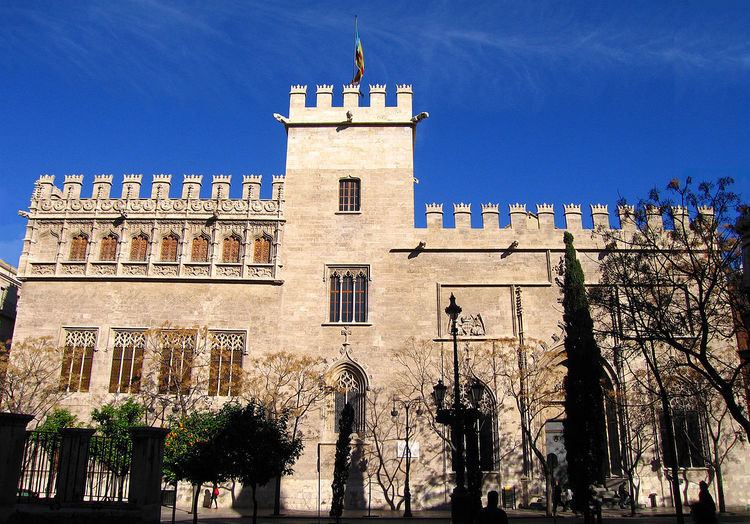Type Cultural Designated 1996 (20th session) State Party Spain Province Province of Valencia Architect Pere Compte | Criteria i, iv Reference no. 782 Opened 1548 Phone +34 962 08 41 53 | |
 | ||
Location Valencia, Valencian Community, Spain Address Carrer de la Llotja, 2, 46001 València, Spain Hours Open today · 9:30AM–7PMThursday9:30AM–7PMFriday9:30AM–7PMSaturday9:30AM–7PMSunday9:30AM–3PMMonday9:30AM–7PMTuesday9:30AM–7PMWednesday9:30AM–7PMSuggest an edit Architectural styles Gothic architecture, Renaissance architecture Similar Mercado Central - Valencia, Plaza de la Virgen, L'Oceanogràfic, City of Arts and Sciences, Valencia Bioparc | ||
La llotja de la seda the silk exchange valencia spain
The Llotja de la Seda ([ˈʎɔdʒa ðe la ˈseða], Spanish: Lonja de la Seda, English "Silk Exchange") is a late Valencian Gothic-style civil building in Valencia, Spain. It is a principal tourist attraction in the city.
Contents
- La llotja de la seda the silk exchange valencia spain
- 1980 la lonja de valencia lonja de la seda g tico civil 1482 llotja de la seda civil gothic
- History
- References
1980 la lonja de valencia lonja de la seda g tico civil 1482 llotja de la seda civil gothic
History
Built between 1482 and 1548, la Lonja is composed of three parts (plus the Orange Garden - a walled court-yard). The main hall, Sala de Contratacion (The Contract Hall) is a large lavishly decorated space supported by gorgeous twisted columns. This was the financial centre of La Lonja, where the merchants work out contracts. The side-wing is named the Pavilion of the Consulate, and this was the seat of the Tribunal del Mar - the first marine merchant tribunal to ever be formed in Spain. The first two floors were the main function rooms, with the upper one hosting a richly decorated ceiling. These rooms are still maintain original furnishings. On occasion, the Tribunal would imprison merchants for debts in the central tower of La Lonja - the third part of the structure.
Behind the current building, there was an earlier one from the 14th century, which was called the Oil Exchange (Llotja de l’Oli, in Valencian, or Lonja del Aceite, in Spanish). It was used not only for trading with agricultural oils, but for all kind of business. Where in 1348 was traded perxal (percale) as some kind of silk.
Valencia's commercial prosperity reached its peak during the 15th century, and led to the construction of a new building.
The design of the new Lonja of Valencia was derived from a similar structure in the Lonja of Palma de Majorca, built by the architect Guillem Sagrera in 1448. The architect in charge of the new Lonja was Pere Compte, who built the main body of the building – the Trading Hall (or Sala de Contractació in Valencian) – in only fifteen years (1483–1498). So is written in a blue band that runs along all four walls of the Trading Hall, also called "Hall of Columns". It proclaims in golden letters the following inscription:
Inclita domus sum annis aedificata quindecim. Gustate et videte concives quoniam bona est negotiatio, quae non agit dolum in lingua, quae jurat proximo et non deficit, quae pecuniam non dedit ad usuram eius. Mercator sic agens divitiis redundabit, et tandem vita fructur aeterna.
According to the local Valencian scholar Joan Francesc Mira, this inscription showed that it was not a necessary to be a Protestant or a foreigner to establish the basis of a good trade; it also showed the union of ethics and economy. Other construction and decoration works lumbered on until 1548, such as the Consolat del Mar (Consulate of the Sea), a Renaissance building adjoined to La Lonja.
During subsequent centuries, La Lonja functioned as a silk exchange. The honesty of its traders is honored by the inscription that runs around the main contract hall.
The UNESCO considered it as a World Heritage Site in 1996 since "the site is of outstanding universal value as it is a wholly exceptional example of a secular building in late Gothic style, which dramatically illustrates the power and wealth of one of the great Mediterranean mercantile cities."
